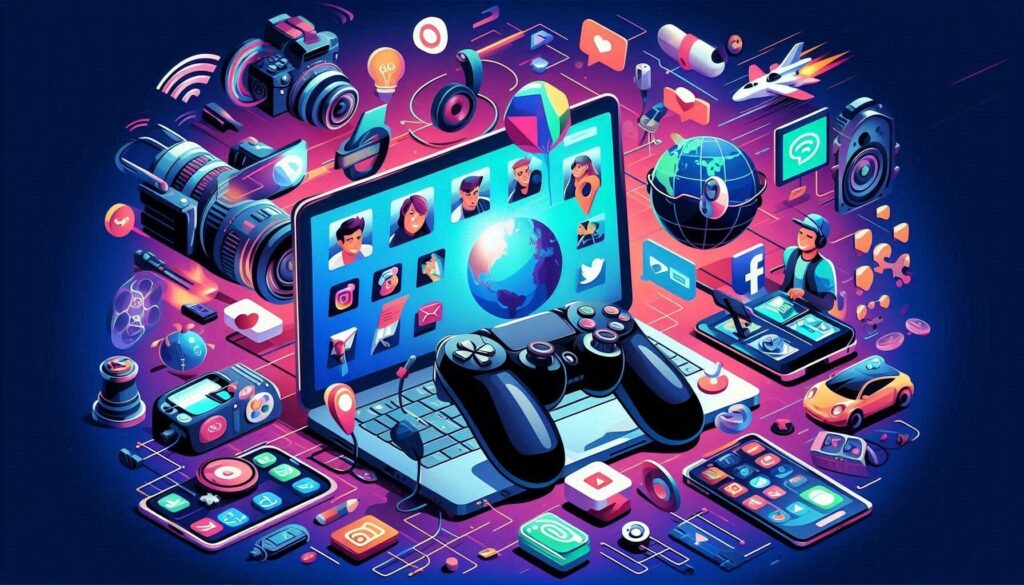Gaming culture has changed a lot over the years. It went from being something only a few people did to something that people all around the world enjoy. Let’s look at how gaming has changed and how it helps people make friends and have fun together.
The Start of LAN Parties
In the 1990s, LAN (Local Area Network) parties were very popular. Gamers would bring their computers to one place, like someone’s house or a community center, and connect them to play games together. These parties were not just about the games; they were about hanging out, sharing snacks, and having fun. People made new friends and enjoyed the excitement of playing games face-to-face.
Even today, some people still have LAN parties, although they are not as common as they used to be. These gatherings keep the spirit of gaming together alive.
Online Multiplayer Games
In the late 1990s and early 2000s, the internet allowed gamers to play together without being in the same room. Games like “Quake” and “Counter-Strike” let people play against each other from anywhere in the world. This was a big change because now people could make friends and play with others from different countries.
With online games, players could chat using voice or text, making the experience more social. This made gaming even more fun and allowed people to form friendships with others who enjoyed the same games.
Massive Online Gaming Communities
As technology got better, games like “World of Warcraft” (WoW) came out. WoW and other massively multiplayer online games (MMOs) created huge virtual worlds where players could go on adventures, join groups called guilds, and battle together. These games needed players to work together, so they became close friends in the game and sometimes even in real life.
These online communities became very important to players. They could spend hours working together to complete missions and quests. Many players would meet up in real life at gaming conventions, where they could see their online friends face-to-face.

Esports Gaming and Streaming
In the 2010s, competitive gaming, called esports, became very popular. Games like “League of Legends” and “Overwatch” had big tournaments with lots of money for the winners. People would watch these tournaments in huge stadiums or online.
Streaming platforms like Twitch and YouTube Gaming let gamers show their gameplay to viewers all over the world. Viewers could chat with the streamers and each other, creating a community of fans who enjoyed the same games.
Streamers often become famous and have lots of followers who watch them play games every day. This made gaming even more exciting, as fans could learn from the best players and cheer them on during live games.
One example of how games celebrate their communities is the new MCC 15 Year Minecraft Cape. This cape is given to players who have been a part of the Minecraft community for 15 years. It shows how long players have been involved and is a special way to honor their dedication. This kind of reward makes players feel appreciated and part of something bigger, strengthening the bond within the gaming community.
Social Media and Online Communities
Social media sites like Reddit, Discord, and Twitter also helped shape gaming culture. These sites let gamers talk about strategies, share artwork, and connect with others who liked the same games. Discord, especially, became a popular place for gamers to chat using voice, video, or text.
Game developers also use social media to talk to fans, get feedback, and build excitement for new games. This makes the connection between game makers and players stronger.
Western vs. Eastern Gaming Culture
Gaming culture can be different in various parts of the world. In Western countries, like the United States and Europe, gaming often focuses on consoles and PC games. People enjoy a mix of single-player and multiplayer games and watch a lot of esports.
In Eastern countries like Korea and Japan, gaming is very popular too. Korea is known for its esports scene, especially games like “StarCraft” and “League of Legends.” Many people play games in internet cafes called PC bangs. In Japan, gaming has a strong focus on both consoles, like the Nintendo Switch, and mobile games. Japanese gamers often enjoy role-playing games (RPGs) and unique game genres that come from Japanese culture.
In Korea, being a professional gamer is a big deal. Gamers there practice for many hours every day and can become famous like sports stars. In Japan, many games have stories that come from manga and anime, which are very popular types of comics and cartoons in the country.
Conclusion
Gaming culture has come a long way from the days of LAN parties to the vast online communities we have now. Gaming helps people make friends and have fun, no matter where they are in the world. As technology keeps getting better, gaming will continue to grow and change, bringing people together in new and exciting ways. Whether it’s through competitive esports, exploring virtual worlds, or watching streamers, gaming has become an important part of our social lives.
LAN parties didn’t go away me and my friends still bring our laptops to each other’s homes and play.
I had heard of korean gamers, but that seemed to me to be the exception. I didn’t know gaming was such a big part of their culture
You would only get on voice chat with people you kn0w, not randos to make new friends. At least that was how I remembered it.
When WoW first came out, could you still consider it an MMO? Since it wasn’t “Massively” multiplayer, would it then have just been a multiplayer game and not massive until it became popular?
fantastic issues altogether, you simply gained a new reader. What would you recommend about your submit that you made a few days ago? Any positive?